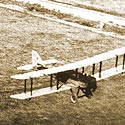
The post office has always sought faster and more efficient means to move the mail. To help speed the mail, the post office often looked to newly developed types of transportation. Through the 1800s, the Post Office Department used America's waterways and railways to convey the mail. In 1900, the most common way that mail traveled was by train. A little more than a decade later, people vastly improved mail delivery by employing the speed of the latest invention, the airplane.

DH-4 biairplane flying
alongside a railroad
The Wright Brothers made their famous first flight in 1903. In the following years, the Post Office Department decided to allow experimental flights to carry the mail. By 1918, a handful of soldiers and six Jenny airplanes left over from World War I made up the first official airmail service. To make mail by air a success, the Post Office worked to improve the airplanes it used and the system of air routes, airfields, beacons and radio network.
Even as airmail service expanded, people felt unsure about sending their mail by airplane. One reason was that airplanes were still relatively new, and some people in America had yet to see one, let alone travel by airplane. Another reason was that sending a letter by airmail cost 24 cents, but regular delivery required as little as a 3-cent stamp. Would you be willing to pay that much more for speed?
Compare the amount of time it took for mail to cross the United States in the first decades of the 20th century. Consider that the first transcontinental (or coast-to-coast flight was in 1911 and took 11 days to complete!
| Year | Mode of Transportation | Coast to Coast Travel Time |
| 1900 | Mail by Train |
4 days - ( The airplane is not yet invented!) |
| 1918 | Mail by Train |
3 days - (The only airmail service available was between Washington, D.C., Philadelphia, and New York. |
| 1926 | Mail by Train | 3 days |
| Mail by airplane | 1 to 1 ½ days |
Do you think it is important to improve the speed of mail delivery? Why or why not?
